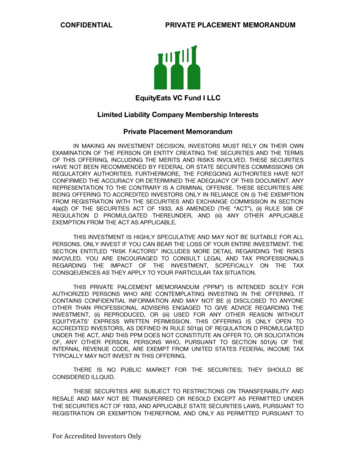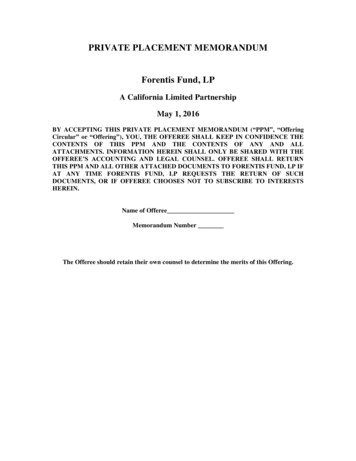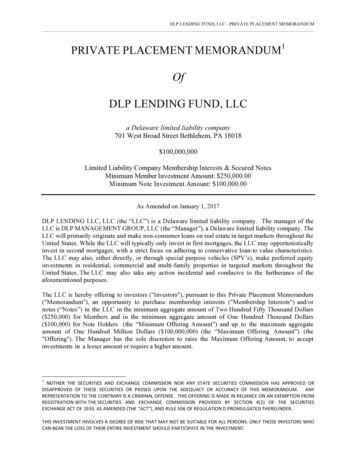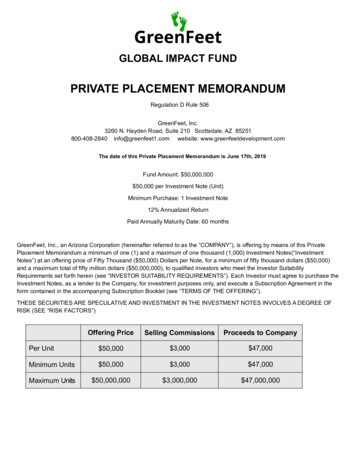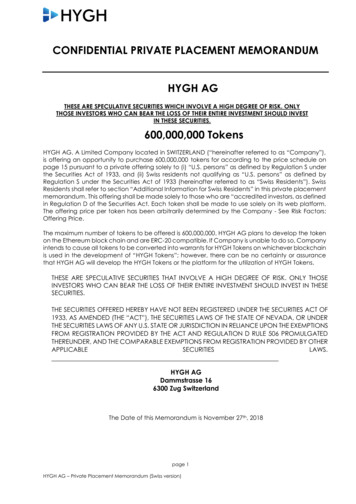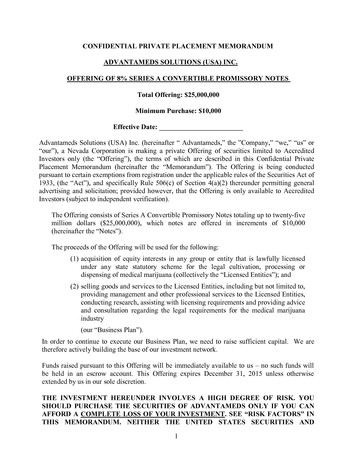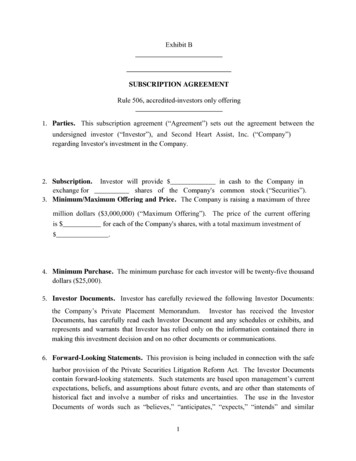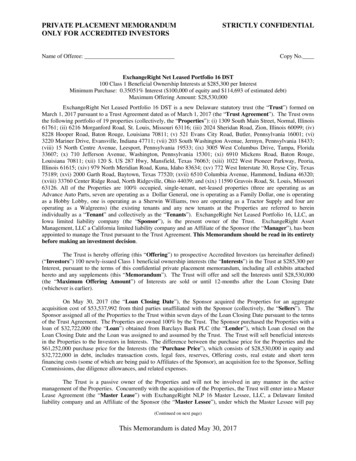
Transcription
MemorandumTo:Geographic Information Office, U.S. Geological SurveyFrom: Peter Van Metre and Barbara Mahler, USGS, Austin, TexasDate:6/8/2007Re:Response to “Complaint About Information Quality” regarding OFR 2004-1208This memorandum is written to reply to each of the 45 complaints under the USGSGuidelines for Ensuring the Quality of Information Disseminated to the Public under theU.S. Data Quality Act submitted by Bracewell & Giuliani LLP, Austin, Texas, on behalfof 10 companies in the sealcoat industry. Some changes are being made to the report inresponse to this complaint; a new version (version 3) will be released on the Internet assoon as practical.Statement 1: Concentrations/runoff and scrapings from test plotsResponse: The intent of the sentence was to say that for a given surface and sample type(e.g., scrapings from surfaces coated with asphalt-based sealcoat), concentrations fromtest plots were similar to those from in-use parking lots, as shown in figure 4. We agreethat the sentence could be misinterpreted, and it will be removed.Statement 2: Citation of a newspaper articleResponse: The source of this background information will be cited as a City of Austin(COA) report (City of Austin, 2005).Statement 3: Citation of a newspaper articleResponse: See response to Statement 2. The source of this background information willbe cited as a City of Austin (COA) report (City of Austin, 2005).1
Statement 4: coal tar versus RT-12Response: Industry product labels and Materials Safety Data Sheets (MSDS) routinelyuse the term “coal tar pitch” or “refined coal tar” rather than “RT-12” (for example,NEYRA industries “Jennite Coal Tar Emulsion” product(http://www.neyra.com/MSDSjenn.htm); NEYRA Industries “Tarconite” product(http://www.neyra.com/MSDStarc.htm); Star Industries “Star Seal Supreme” SDS-SSS.pdf)). Industry web sites referto “coal tar products” (for example, Tangent Rail Products, athttp://www.tangentrail.com/tangent-p-s.html) and “coal tar emulsion” products (forexample, Cooper Creek “Black Velvet Blacktop Sealer,” tml). The MacRae’s Blue Book“Industrial Directory Yellow Pages” (www.macraesbluebook.com) located 61companies when searched for “coal tar” (although not all provide sealcoat), and foundnone when searched for “RT-12.” The term RT-12 is not widely used, even by industry,and does not have a CAS number. In contrast, coal tar and coal-tar pitch do have a CASnumber: 65996-93-2. We conclude that our use of “coal-tar-emulsion-based” isaccurate and consistent with industry naming conventions and see no utility in changingto the term RT-12. We will, however, add the word “refined” to “coal tar” in theintroduction for clarity when the product is first described.Statement 5: Reapplication 2–3 yearsResponse: The statement of reapplication every 2–3 years is based on product labels,applicator and product Web sites, and conversations with industry representatives duringtwo industry briefings arranged by the City of Austin. For example, in a recent review ofindustry Web sites (November 22, 2006), we located the following:Riegler Blacktop, Inc., recommends reapplying Brewer Cote coal-tar emulsion sealcoatevery 2–3 years olorado Asphalt Services, Inc., recommends resealing every 2–3 years(http://www.coloradoasphalt.com/FAQs.htm); Carolina Asphalt states that an“application should last 2–3 years” (http://www.carolinaasphalt.com/services.html); andAsphalt Sealcoat Manufacturers Association recommends resealing every 3–4 hen%20Should%20sealcoating%20be%20done).These URLs will be added as references, and because not all companies recommend the2–3-year reapplication schedule, we will reword the sentence to read, “Many companiesrecommend reapplication every 2–3 years.” As the source of the information is thesealcoat product and applicator industry itself, we assume that it is reliable.We are unaware of any independent, peer-reviewed studies of wear rates for differenttypes of sealcoat and thus are not able to include any “relevant distinctions betweenanticipated longevity of different sealer products,” per request. The statement was2
included so that the reader would understand that sealcoat wears off, a point implicit inrecommended reapplication rates.None of the authors of the study recall making the statements in public presentationsthat were attributed to them in the Objection.Statement 6: 660,000 gallonsResponse: A check of the cited source Internet URL(http://www.ci.austin.tx.us/watershed/bs coaltar.htm) on December 11, 2006, indicatesa link titled “City Presentation” from the cited URL to the presentation containing theannual-use estimate. However, whether the link is there or not is moot because theannual-use estimate now appears on page 2-1 of the COA report “PAHs in Austin,Texas Sediments and Coal-Tar Based Pavement Sealants”dated May s/coaltar draft pah study.pdf). We willrevise OFR 2004–1208 to reference this report because it is now posted on the Web.The information was provided by Bruce Lowry, of Wheeler Coatings Asphalt, LP.,Round Rock, Tex. Mr. Lowry cited use of 650,000 gallons per year; an additional10,000 gallons annually is sold off-the-shelf, a figure obtained by COA through pollingof suppliers. As with other sources that are criticized in the Complaint as “. . . serves orintends to elevate unreliable information . . . ,” we believe that this reference providesuseful context information as part of the introduction.Statement 7: coal tar PAH and fraction in sealcoatResponse: The statement is made to inform the reader that coal-tar sealcoat productscontain high levels of PAH because (1) coal tar is predominantly PAH, and (2) sealcoatcontains a large percentage of refined coal tar. The high PAH content of coal tar issupported by a large body of literature, one source of which is referenced in OFR 2004–1208. The percentage of refined coal tar in a sealcoat product is listed in the productMSDS; these numbers are consistent with tests performed by COA showing a mean of8.4 percent “total” (sum of 16 parent) PAH in six coal-tar sealcoat products (note thatthe 16 parent PAHs make up only a fraction of true total PAH). In the interest of clarity,we will change the phrase “20- to 35-percent coal tar by weight” to “20- to 35-percentrefined coal tar by weight,” as this is the terminology we have found in the productMSDS and product descriptions (see Statement 4), including that provided by TheBrewer Company, one of the Affected Parties(www.thebrewerco.com/pdf Files/15000.pdf, 15000 Series Pavement Sealers, RefinedCoal Tar Pitch, 35 % by weight). We do not agree with the complaint and request forrelief that a more detailed description of the “process of distillation and thenemulsification . . .” is necessary.3
Statement 8: COA product analysesResponse: The laboratory used by COA (DHL Analytical, Round Rock, Tex.) uses acertified U.S. Environmental Protection Agency method (EPA SW8270) for their PAHanalyses; the subject data (PAH analyses of sealcoat products) are now included in aCOA ads/coaltar draft pah study.pdf) (City ofAustin, 2005). The reference will be changed to the COA report.Statement 9: purposeResponse: The purpose of a study and the purpose of a report often are different, as isthe case with this study and this report. Accordingly, USGS authors are instructed toinclude the purpose (or objective) of the study as distinct from the purpose of the report.Per common USGS report-writing practice, the purpose of the study is to be discussedin the introduction of a USGS report preceding the statement of purpose of the report.As a matter of USGS Water Resources Discipline policy(http://water.usgs.gov/wid/FS 217-95/guide.html), all USGS-series reports are toinclude an explicit statement of the purpose (and scope) of the report, commonly inbook reports under a second-order heading in the Introduction called “Purpose andScope” The purpose of this report is to present the methods and data for the study, andthus addresses but one part of the broader-purpose study that includes interpretation ofthe data. The contents of OFR 2004–1208 are consistent with the stated purpose of thereport. Because the form and content of the statements of purpose of the study andreport are accurate and consistent with USGS policy and common USGS report-writingpractice, no revisions were made.Statement 10: applicationResponse: This objection refers to a brief, introductory statement included in the“Purpose and Scope” section of the report.To remove any implication that “a single type of” coal-tar-emulsion sealer was appliedto both test plots, the article “a” preceding “coal-tar-emulsion sealer” will be deletedfrom the subject sentence; and for parallel construction, the article “an” preceding“asphalt-emulsion sealer” also will be deleted.Statement 11: frequency of test plot sampling, curing, and rainfallResponse: This objection refers to another statement in the “Purpose and Scope”section of the report that is intended to briefly summarize the approach of the study, and4
thus by extension the scope of the material the reader will find in the report. Thissection of the report is not meant to provide a comprehensive description of methods.Regarding the issue of curing time, table 1 indicates that the test plots were sealedAugust 5 and 6, 2003, figure 2 and table 2 indicate that the first dissolved PAH sampleswere collected August 12, 2003, and figure 3 and table 3 indicate that the firstparticulate PAH samples were collected on August 21, 2003. The information in thesefigures and tables is sufficient for readers to determine that the time between applicationof the sealant and collection of the dissolved and particulate samples (the curing time)was 6 and 15 days, respectively. We do not agree that additional clarification in the textis warranted. The PCTC Guide Specification-PCTC01 specifies a minimum of 8 hoursdaylight curing time in good weather, and (in some cases) in excess of 24 hours inmarginal weather conditions “before opening to traffic, and initially cure enough todrive over without damage to the sealcoat.” If these curing times are sufficient to allowtraffic to drive over the sealcoat without damage to the sealcoat, it is reasonable tobelieve a reader would conclude that curing times of 6 to 15 days are sufficient not towarrant “discussion of the curing time.” We are unable to respond to the AffectedParties’ request for a discussion of curing and PAH aging because their definition of“complete curing” is unknown, and the affects of curing and PAH aging are unknown.Regarding the request for rainfall times and amounts and approximate temperatures,weather data are available to the public for numerous locations in Austin. NationalWeather Service rainfall data from Camp Mabry covering the project sampling periodwill be added to the report to indicate rainfall conditions in Austin prior to sampling.Statement 12: scraping at most sitesResponse: The objection refers to a statement in the “Purpose and Scope” section of thereport which, as noted previously, is not intended to provide a comprehensivedescription of methods. Dates of scraping and washoff sampling and the surfaces thatwere sampled are provided in table 2.The effect of rainfall history was not examined because PAHs are highly insoluble; thuswe would not expect rainwater to extract (remove) these compounds from the adheredsealcoat surface. The scraping samples consist of the adhered sealcoat surface, thusrainfall is not expected to change the chemical composition of the scrapings.The following text will be added to the report at the end of the last paragraph in thesection “Sample-Collection Methods” to identify which three lots were excluded fromthe collection of scraping samples and explain their exclusion: “Scraping samples werenot collected from the two unsealed concrete lots because it was assumed that theconcrete contains almost no PAH (PAHs are hydrocarbons and thus are associated withfuels (coal, oil, wood) and combustion of fuels). One sample from an asphalt-emulsionsealed lot was not analyzed because the sample was corrupted.” The technician who5
collected the corrupted sample included a large amount of debris (leaves, grass cuttings,dirt, etc.) in the sample. This sample was not analyzed because the scrapings sampleswere designed to consist exclusively of adhered sealcoat.Statement 13: dissolved PAH subset of sitesResponse: PAHs are very hydrophobic compounds and their transport in streams isdominated by the particulate phase (suspended sediment) (Bradford and Horowitz,1988; Foster and others, 2000; Ko and Baker, 2004). Therefore, the primary focus of thestudy was particle-phase transport from the parking lots. Nineteen samples wereanalyzed for dissolved-phase PAHs from a subset of sites, which included coal-taremulsion sealed, asphalt-emulsion sealed, and unsealed surfaces. The sites in the subsetwere selected on the basis of field convenience, while ensuring that at least one each ofthe three surface types was represented. Results for dissolved-phase samples arepresented in table 3; the sites not sampled for dissolved-phase concentrations can beidentified by their omission.Statement 14: arranged for sealingResponse: The subject text in OFR 2004–1208 will be modified to present additionaldetails per request. The text will read as follows:The test plots were in the parking lot of Robert Mueller Municipal Airport (fig. 1). Theairport was closed in 1999, and the parking lot has been in minimal use since then.Sometime before 1999, a coal-tar sealer was applied, which appeared to have worn off bythe time of this study. Three of the test plots are 11- by 11-meter areas that were sealedduring August 5–6, 2003 (table 1). Wheeler Coatings Asphalt, Inc., a commercialpavement-sealing company, on a voluntary basis, agreed to apply a refined coal-tar sealer(Tarconite, less than 34-percent coal tar by weight) to one site (TAR) and an asphalt sealer(Paveshield, less than 35-percent asphalt resin by weight) to one site (PAV). Wheelerpersonnel prepared the site for application by blowing off debris and priming oil andgrease spots and applied the two commercial products according to manufacturers’specifications. Application of the coal-tar product also conformed to FederalSpecifications R-P 335e Pitch, Coal Tar Emulsions and PCTC Guide SpecificationPCTC01. A retail refined coal-tar sealer (Henry Minuteman - Monsey, 33-percent coal tarby weight), a product available to homeowners for application to residential driveways,was applied to one site (MON) by City of Austin staff following the manufacturer’sinstructions. No sealer was applied to the control site (ASP). The test plots receivedvirtually no vehicle traffic during the 2-month duration of the sampling.Statement 15: choice of lotsResponse: The relevent technical criteria used to select the sampling sites from the“universe of lots” are described in the paragraph cited. The only additional6
“operational” criteria for sampling were (1) that information could be obtainedregarding the date of application and type of sealcoat applied and (b) that permission tosample could be obtained. These operational criteria do not contribute informationnecessary to understand the study design and thus were not included in the text. Wehave assumed that the alleged contradiction refers to the phrase “represent a range of . . sealer ages.” Data from tables 1 and 2 provide sufficient information to deduce thatthe six in-use, coal-tar-emulsion-sealed parking lots sampled reflect sealer ages rangingfrom approximately 2 to 50 months. Of the 12 samples (6 washoff and 6 scraping) fromthe six lots, six were collected from an approximately 2-month-old sealcoat surface, twofrom an approximately 6-month-old sealcoat surface, two from an approximately 35month-old sealcoat surface, and two from an approximately 50-month-old sealcoatsurface. We do not believe that the aforementioned mix of sealer ages represented byour samples can be fairly characterized as “heavily overrepresented by very recentlysealed lots with minimal curing time.” We did not follow any “inclusion/exclusioncriteria” related to sealer ages or any other parking lot characteristic. We do not believethat site-selection criteria or range of site ages warrants additional discussion in thereport.Statement 16: unreliable info on type and date of sealingResponse: The best information available was used. The information was cross-checkedto the extent possible, for example, by checking the MSDS for the reported products,assuming that the MSDS are accurate on sealer contents. We do not believe anyadditional discussion is warranted.Statement 17: 5 days no rainResponse: As noted in the response to Statement 11, rainfall data covering the projectsampling period will be added to the report. We are not aware of any studiesdemonstrating the short- or long-term (6 months or more) effects of “curing and washoffof the removable material” alluded to by the Affected Parties. The attempt to collectparticle-phase washoff samples on August 12, 2003, from the first lot sampled soonafter a rain event produced insufficient mass of particles for analysis, so the sampling ofparticle-phase washoff was aborted and only dissolved PAHs were measured. Thisinitial sampling attempt did not adhere to the 5-day limit because one objective of thetest-plot sampling was to evaluate the effects of curing over the initial days and weeksafter application, and an initial sampling within 1 week of application was part of theproject plan.7
Statement 18: dissolved onlyResponse: Please refer to our response to Statement 17. We attempted to collectparticle samples on August 12, 2003, despite rainfall on the previous day. The plancalled for the collection of the first sample from the test plots within 1 week of sealantapplication, and the sampling criteria called for a minimum of 5 days of no rain prior tosampling; the decision to attempt to collect a sample despite rainfall on the previous daywas a judgment decision on the part of the Project Chief (Van Metre), who was requiredto balance the competing needs of the project plan and the sampling criteria. Van Metreconcluded after the first sample (TAR) that they would not be able to collect enoughmaterial for particle analysis. This decision was based on his experience withsuspended-sediment particle sampling; analysis of suspended-sediment concentration(SSC) is not done in the field, so the decision could not be made on the basis of SSCdata. Dissolved samples, however, were collected on August 12, 2003, because samplevolume for analysis was not a limitation. For one of those samples, MON, an SSCanalysis was done (presented in table 5).Other plots were not sampled, even if sufficient material might have been obtained,because the project plan specified sampling all four test plots on the same time interval(i.e., all sites to be sampled on the same day each time). Based on SSC concentrationsmeasured at MON on August 12, 2003, the statement by the Affected Parties, “Had thesame amount of water and area been sampled from these plots as was used on the TARplot, sufficient material could have been collected on the filters to permit analysis for theother three plots“ might be correct, at least for the MON site. However, as the SSC datawas not available onsite, the decision not to continue collection of suspended sedimentshad to be made on the basis of professional judgment.Regarding the Affected Parties’ specific questions in paragraph 5, beginning with “Inthese circumstances, what basis ”: As stated above, Van Metre concluded that therewas insufficient sediment for analysis o
To remove any implication that “a single type of” coal-tar-emulsion sealer was applied to both test plots, the article “a” preceding “coal-tar-emulsion sealer” will be deleted from the subject sentence; and for parallel construction, the article “an” preceding “asphalt


